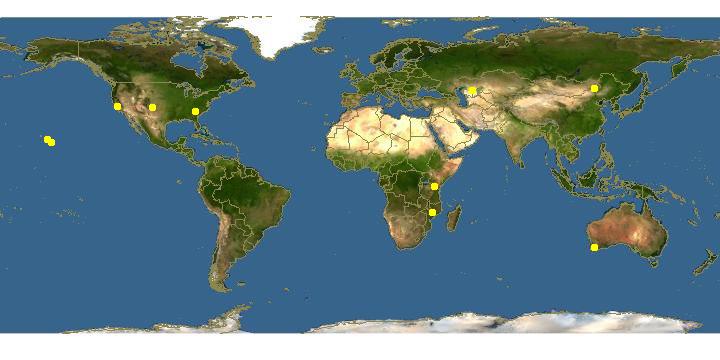
Click on map for details about points.
|
|
Overview | |
Grows and sporulates on malt-yeast extract agar with an unidentified bacterium, isolated from hickory bark, as its food source. The species has a restricted pH tolerance in culture and fails to grow if the pH deviates significantly from 5.1. P. fragile is readily distinguishable from the other 2 species of Protosporangium by its consistently 4-spored sporangia and the fragile stalks, which fragment into small segments when mounted on a slide. Sporocarps 65-225 tall; stalk fragile, readily fragmenting; sporangia globose to subglobose, 7.5-11 diam., 4 spores 4.3-5.5 x 5.3-7.5, each giving rise to 2 flagellate cells just after germination. The trophic stage consists of uninucleate to plurinucleate ameboid protoplasts. Because of the small nucleoli the nuclei in the larger protoplasts are inconspicuous and cannot be counted. When placed in water, filose pseudopodia are produced by the protoplasts, but flagella are absent. The vermiform stage (similar to P. bisporum) is readily reversible to the flattened ameboid phase. The flagellate cells commonly have either 1 long anterior flagellum, paired with a short reflexed one about 1/3 its length, or a pair of long flagella. The long flagellum tapers narrowly towards its apex. The short flagellum tends to lie against the side of the cell and usually is inconspicuous. Pseudoflagella commonly appear at the apical end of the cell and migrate to the posterior where they disappear. The nucleus, containing a small central nucleolus, is situated in the more or less hyaloplasmic anterior 1/3 of the cell. The prespore cells behave as specialized cells that do not readily revert to the trophic condition. Cysts globose, oval, oblong, or occasionally irregular, 10-27 x 13.8-35.
|
|
|
Links to other sites | |
|
|
|
Acknowledgements | |
The Eumycetozoan Project -- working to understand the ecology, sytematics and evolution of myxomycetes, dictostelids and protostelids -- the true slime molds.
Sponsored by grants from the National Science Foundation.
|
|
|
Feedback |
Please send any corrections and comments about this page to John Shadwick
Department of Biological Sciences, University of Arkansas, Fayetteville, AR 72701, USA
email: jshadwi@uark.edu
phone: USA-479-575-7393.
|
|
| Supported by | |
Updated: 2024-04-24 01:12:23 gmt
|